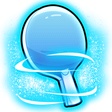Serving Rules
General
John Russo Asked 16 years ago
I have never been able to find a clear answer about this online. When a person serves does the ball have to go off the back of the table on the opponents side or is it aloud to go off the side of the table.
Thanks
John
 Jeff Plumb Answered 16 years ago
Jeff Plumb Answered 16 years ago
Hi John,
The ball is allowed to go off the side of the table. In fact the only requirement is that the ball first bounces on your side and then bounces on your opponents side, after that the ball can do whatever it likes. The ball could be served short so that it would bounce twice or more times on the table. It is even legal to put a lot of backspin on the ball so that it bounces back over the net.
In singles you can serve from anywhere to anywhere. In doubles the rules are different and you must always serve from the right hand side to your opponents right hand side. We cover this in our Table Tennis rules made easy lesson.
Recommended Video
Doubles Serving Rules
In this video we go over the somewhat complicated rules of serving for doubles in table tennis. There are a couple of extra rules for doubles that you don't apply to singles. In doubles you always serve from the right hand box diagonally to your opponent's right hand box. Each player has 2 serves each. If you've just been receiving then it's your turn to serve next.
Watch NowThoughts on this question
Become a free member to post a comment about this question.
Fred Unknown Posted 16 years ago
Yup
But in Paralympic table tennis the ball must cross the back end before the sides and I'm not sure but I think only one bounce is allowed, so they can actually have a chance at returning the serve
Thanks for the extra information Fred.
Here is an extract from the ITTF rules relating to wheelchair table tennis. The serve is a let if it starts to go backwards towards the net. But it is allowed to be a short serve as long as it is still going forward and, if left, will eventually leave via the endline.
2.09.01 The rally shall be a let;